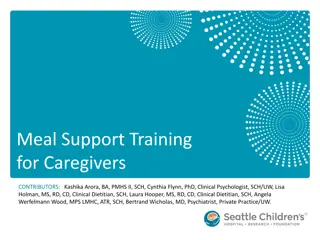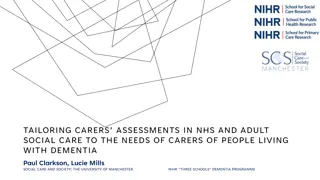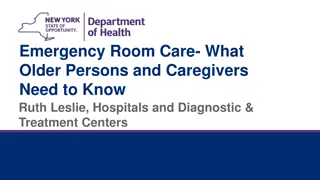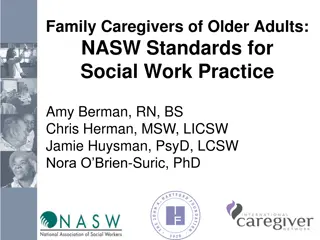Impact of Work-Care Conflict on Caregivers in Canada
The current state of work-care conflict in Canada is illustrated through the impact on caregivers' employment, finances, health, and social well-being. Statistics reveal the challenges faced by caregivers, such as job loss, financial hardship, health issues, and strained relationships. The data highlights the significant repercussions caregivers experience due to balancing work and caregiving responsibilities.
Download Presentation

Please find below an Image/Link to download the presentation.
The content on the website is provided AS IS for your information and personal use only. It may not be sold, licensed, or shared on other websites without obtaining consent from the author. Download presentation by click this link. If you encounter any issues during the download, it is possible that the publisher has removed the file from their server.
E N D
Presentation Transcript
Mapping the current state of work-care conflict in Canada Law, Work and Family Care Symposium, Toronto ON February 17-18, 2017 Janet Fast, PhD Research on Aging, Policies and Practice (RAPP), University of Alberta
Carers Carers in Canada in Canada are Common Carers in Canada are Valuable x 8.1 million caregivers = Average 9 hrs/ Average 9 hrs/wk women and 6.9 for men women and 6.9 for men wk for for = > 10 x 1.5 billion hours of care the amount of paid care provided
Impact on Impact on carers carers Employment Non-dementia CG Dementia CG You have a choice, to place him and stay employed or to keep him [at home] and you re terminated. Your choice. I was terminated and there went my income of $10,000 a month, right out the window. (Rachel, caring for spouse with brain injury) 50 47 43 45 40 35 % of caregivers 30 22* 25 20 15* 15 7* 10 4* 5 0 Absenteeism Reduced hours LF Exit in last 12 months * Significant at p < 0.5 or greater Source: GSS 2012; Unpublished analyses, RAPP
Impact on Impact on carers carers Finances Non-dementia CG Dementia CG 100 93 92 90 80 73 70 % of caregivers 61 60 49 50 43 35 40 33 28 26 26 30 21 20 18 20 10 0 Had extra expenses Had financial hardship Modified spending Deferred savings Borrowed money from family/friends Took loan from bank Sold assets in last 12 months * Significant at p < 0.5 or greater Source: GSS 2012; Unpublished analyses, RAPP 4
Impact on Impact on carers carers Health We can t do caregiving seven days a week, 24 hours a day, 365 days a year. Nobody can do that. I did and I died. and the mental health, it s even harder, so who are we kidding? (Donna, employed caregiver) Non-dementia CG Dementia CG 80 71* 70 61* 54* 60 50* % of caregivers 50 44* 40 33* 29* 28* 30 19* 19* 20 * 10 0 Health suffered Worried Tired Sleep disturbed Depressed * Significant at p < 0.5 or greater Source: GSS 2012; Unpublished analyses, RAPP
Impact on Impact on carers carers Social Well-being Non-dementia CG Dementia CG 70 60* 60* 57* 60 50* 47* 50 45* 44* % of caregivers 40* 36* 40 30 26* 23* 17* 20 10 0 With partner With children With friends On activities Strained relations Felt lonely Spent less time * Significant at p < 0.5 or greater Source: GSS 2012; Unpublished analyses, RAPP J. Fast (2016): Slide 6
Impact on Impact on carers carers: : Risk Factors Intensity of care: providing >10 hr/wk of care caring for more than 1 person Relationship: caring for a spouse or adult child Geographic proximity: co-residing with care receiver commuting to provide care (30 min to 3 hours) Caring for someone with a cognitive condition
Implications for Implications for Employers 9,700,000 days of absenteeism. 256,000,000 fewer hours of paid work. 557,698 carer-employees left their jobs to provide care. $1,825,893,223 in lost productivity (absenteeism and turnover)
Implications for Implications for society and economy Sustainability of family care sector sustainability of formal health care sector Caregivers do the same amount of work as 1.2 million FT employees Expenditures on income security benefits Lost income tax revenues In 2012 caregivers providing the most care net cost to government of $641 million in lost income tax revenues and higher SA benefits
Key messages Many employees have adult/elder care responsibilities: 30-35% and Carers now = 30% of work force Care-related employment consequences are common; have significant costs for caregivers, employers, labour force, broader economy Public policy and workplace initiatives can keep many caregiver employees engaged and productive 10
For further information For further information Janet Fast, PhD jfast@ualberta.ca Research on Aging, Policies, & Practice (RAPP) Room 3-02 Human Ecology Bldg. University of Alberta Edmonton AB CANADA T6G 2N1 http://www.rapp.ualberta.ca/




























